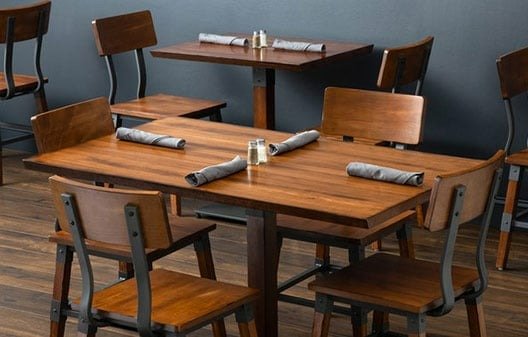Restaurant Tables: Choosing the Perfect Table for Your Dining Space

In the restaurant industry, the choice of furniture plays a crucial role in creating a welcoming and comfortable dining environment. Restaurant tables, in particular, are more than just a functional element—they set the tone for the dining experience and impact customer satisfaction. Whether you’re opening a new restaurant, renovating an existing one, or simply upgrading your furniture, selecting the right restaurant tables is vital to the success of your business.
Why Restaurant Tables Matter for Your Business
The right restaurant tables do more than just provide a surface for customers to eat on. They contribute to the overall aesthetic of the space, influence customer comfort, and can even impact turnover rates. When selecting tables for your restaurant, it’s important to consider several factors, including:
- Durability: Restaurant tables endure heavy use, so they must be made from durable materials that can withstand daily wear and tear.
- Comfort: Tables should be the right height and size for your seating arrangements, ensuring customers have a comfortable dining experience.
- Style: The design of your tables should align with your restaurant’s theme and décor, whether you’re running a casual diner, an upscale bistro, or a family-friendly establishment.
- Functionality: Depending on your restaurant’s layout and seating capacity, you may need tables that are flexible and easy to rearrange for different group sizes or events.
By choosing the right tables, you can enhance the dining atmosphere, improve the overall customer experience, and increase the likelihood of repeat business.
Types of Restaurant Tables
There are various types of restaurant tables, each suited for different dining styles, layouts, and customer preferences. Below, we’ll explore the most common types of tables found in restaurants, along with their unique features.
1. Dining Tables
Dining tables are the most traditional type of table found in restaurants. These tables come in a variety of shapes—rectangular, square, round, and oval—and can be made from various materials, such as wood, metal, or laminate.
- Wooden Dining Tables: These tables offer a classic, warm look that works well in both casual and upscale settings. Solid wood tables are durable and can be easily refinished if they show signs of wear.
- Metal Dining Tables: Often found in modern or industrial-themed restaurants, metal tables are durable and easy to clean. They also provide a sleek, contemporary look.
- Laminate Dining Tables: Laminate tables are affordable and resistant to stains and scratches, making them ideal for high-traffic establishments.
2. Bar Height Tables
Bar height tables, also known as pub tables, are typically taller than standard dining tables and are often used in bar areas, lounges, and casual dining spots. These tables are perfect for creating a more relaxed and social atmosphere.
- Benefits: Bar height tables allow for more standing space and create a vibrant, casual environment. They are often paired with bar stools or high chairs, encouraging interaction and conversation among diners.
3. Booth Tables
Booth tables are designed to be used with booth seating, offering a more private and intimate dining experience. These tables are typically rectangular or square, fitting seamlessly into booth setups.
- Advantages: Booth seating with booth tables can create a cozy and intimate environment, making them popular in family-friendly restaurants, cafes, and diners. They are also space-efficient, allowing you to seat more customers in a smaller area.
4. Outdoor Tables
For restaurants with outdoor seating areas, outdoor tables are essential. These tables are built to withstand the elements, so they’re typically made from materials like metal, treated wood, or plastic.
- Weather Resistance: Outdoor tables must be durable enough to handle exposure to sun, rain, and wind. Materials such as stainless steel, aluminum, and treated wood are commonly used because they are resistant to rust and decay.
- Portability: Some outdoor tables are designed to be lightweight and easy to move, allowing you to rearrange your outdoor seating area as needed.
Materials Used in Restaurant Tables
The material of your restaurant tables plays a significant role in both the aesthetic and practicality of your dining space. Here are some common materials used in restaurant tables:
1. Wood
Wooden tables are a popular choice for their timeless appeal and versatility. They can be crafted from various types of wood, including oak, maple, cherry, and pine, each offering different levels of durability and aesthetic qualities.
- Pros: Warm, inviting appearance; can be refinished if damaged; available in various finishes and styles.
- Cons: Prone to scratches and stains; requires regular maintenance to preserve its appearance.
2. Metal
Metal tables are known for their durability and contemporary design. They’re often used in industrial or modern-themed restaurants.
- Pros: Extremely durable; resistant to stains and damage; easy to clean.
- Cons: Can feel cold and uninviting; may not fit with certain restaurant themes.
3. Laminate
Laminate tables consist of a synthetic material bonded to a base layer, offering a wide range of design possibilities. Laminate is often used in casual dining settings due to its affordability and resistance to damage.
- Pros: Affordable; resistant to scratches and stains; easy to clean.
- Cons: Not as durable as solid wood or metal; can chip or peel over time.
4. Glass
Glass tables are less common in restaurant settings but are sometimes used in upscale or fine dining establishments for their sleek, modern look.
- Pros: Elegant and stylish; easy to clean; reflects light to brighten the space.
- Cons: Fragile and prone to breakage; requires frequent cleaning to maintain its appearance.
Factors to Consider When Buying Restaurant Tables
When selecting restaurant tables, there are several key factors to keep in mind to ensure they meet your business’s needs:
1. Size and Shape
The size and shape of your tables should align with the layout and seating capacity of your restaurant. For example, rectangular tables are ideal for maximizing seating in narrow spaces, while round tables encourage social interaction and are great for communal dining.
2. Maintenance and Cleaning
Restaurant tables must be easy to clean and maintain, especially in high-traffic areas. Tables with smooth surfaces, such as laminate or metal, are easier to wipe down quickly between seatings, while wooden tables may require more regular upkeep to prevent wear and tear.
3. Budget
Your budget will play a major role in determining the type and quality of tables you choose. While solid wood tables may be more expensive upfront, they offer long-term durability and a classic aesthetic. On the other hand, laminate tables provide an affordable option for high-traffic areas without sacrificing style.
4. Customization Options
If your restaurant has a specific theme or branding, you may want to consider customized tables. Customization options include choosing specific finishes, sizes, and materials that align with your restaurant’s décor and concept.
Conclusion
Selecting the right restaurant tables is a critical decision that can significantly impact your restaurant’s atmosphere, customer experience, and overall success. Whether you’re looking for durable wooden tables for a classic diner or sleek metal tables for a modern café, the options are nearly endless. By considering factors like durability, style, and functionality, you can make informed choices that enhance both the aesthetic appeal and practical function of your dining space.



